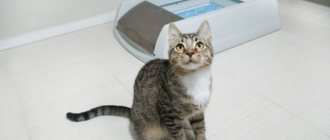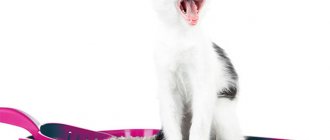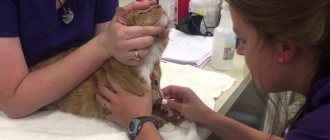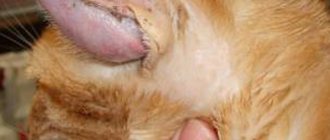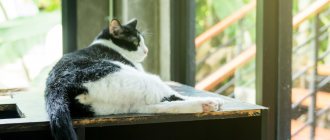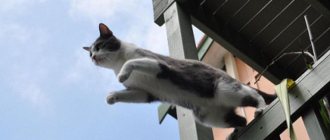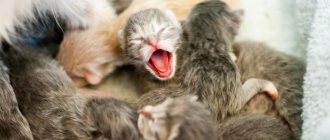Causes
Pus from the nose
Diseases in which pus is discharged from the nose are divided into contagious and non-contagious.
The following are considered contagious:
- Herpes (rinotracheitis);
- Calicivirus;
- Cat flu;
Among the diseases of non-contagious etiology, the following most often develop:
- chronic diseases and colds;
- foreign bodies;
- congenital anomalies;
- tumors.
The causes of diseases, clinical symptoms, methods of diagnosis, treatment and prevention are not the same. Let's consider each disease separately.
Herpes (rhinotracheitis)
Herpes
The disease occurs among unvaccinated cats when kept in crowded conditions, unbalanced feeding in nurseries or shelters. Sick kittens die 10-14 days after the first signs appear. Those who have recovered become a reservoir of infection. There is a high probability of transplacental infection. The owner brings the virus into the apartment.
In addition to nasal discharge and cough, stomatitis, conjunctivitis with subsequent ulceration of the cornea, and mouth breathing develop. Constipation occurs and pregnant women abort. In the chronic course of the disease, panophthalmitis develops and the cat goes blind. An accurate diagnosis is established in the clinic.
The treatment is developed by a veterinarian. Prevention consists of timely vaccination, bringing living conditions and feeding into compliance with standards. If a cat refuses to eat for a long time, it is fed through a nasoesophageal tube. If signs of dehydration are detected, droppers with plasma substitutes are placed.
Nasoesophageal tube
When the cat begins to feed on its own, the veterinarian prescribes wet canned food or soaked granules.
Be sure to read:
A cat sniffles through its nose: reasons, what to do when it is normal, sniffling is a sign of disease
Calicivirus
Ulcerative glossitis with calcivirosis.
In terms of symptoms, etiology, and pathogenesis, the viral disease resembles Herpes. A cough occurs and bronchopneumonia develops.
Distinctive features are ulcerative stomatitis and the absence of ulcerations on the cornea. Lameness appears suddenly, but disappears spontaneously after a few days. The treatment strategy and prevention are the same as for Herpes.
Cat flu
Polyvalent vaccine
Often Herpes and Calicivirus affect a pet at the same time. The disease was called cat flu. When making a diagnosis, attention is paid to the presence of signs of both diseases. A complex vaccine against calicivirus, rhinotracheitis and panleukopenia reliably protects against infection.
Cat flu is not dangerous to humans.
Prevention
The pet is protected from irritants - dust, tobacco smell, perfumes. Provide balanced nutrition. If a felinologist does not have the skills to prepare a diet from natural products, it is better to use factory-made food. To avoid contracting cat flu, your pet is vaccinated in a timely manner.
Multifel-4
Discharge of clear fluid from the nose indicates that a foreign object has entered the nostrils, an allergic reaction, or a contagious disease. If an alarming symptom occurs, contact a veterinarian. You cannot treat the disease yourself with human medications, as well as folk remedies.
We invite you to join our Zen channel and group on VKontakte or Odnoklassniki, where new articles for pet owners are published.
Similar articles:
- My cat has a nosebleed - what should I do?
- Inflammation of the lower lip in a cat
- Papillomas and warts in cats
Chronic diseases and colds
Rhinitis occurs as a symptom of exacerbation of the following permanent diseases:
- diabetes;
- urolithiasis disease;
- renal pathologies.
Too frequent bathing leads to hypothermia and reflex swelling of the mucous membrane. Ventilating rooms freshens the air, however, cats cannot tolerate drafts and become hypothermic. In hot weather, you should not leave your pet in a room with air conditioning running, otherwise he will catch a cold.
If the disease is caused by hypothermia, and the pet’s health is satisfactory, use dual-use drops - Maxidin or Anandin. Drugs intended for humans should not be used without the approval of a veterinarian.
Treatment of pus
Before going to the veterinarian, you can provide first aid to the animal yourself. You can help an animal that has contracted an infection by doing the following:
You can rinse your nose from pus with solutions of boric acid (2%), zinc sulfate (1%), and saline solution. They can also be used to soak crusts;
Instillation of antiviral drops: Gamavit, Vilprofen, Maksidin, Thymogen, Anandin. You can also use baby drops, but only for one time. They eliminate only the symptoms (constrict blood vessels), without interacting with viruses and bacteria;
The use of different widow drops: antiviral and immunostimulating. There should be 2 hours between using drops of the same type.
Congenital anomalies
Spontaneous selection leads to the birth of offspring predisposed to rhinitis. Sometimes kittens are born with a deviated nasal septum.
Hypothermia or a reaction to odors leads to reflex swelling of the mucous membrane and rhinitis. Atopic dermatitis occurs in predisposed cats over one year of age. This is a reaction to dust, smoke and odors. Along with a runny nose, cats develop cough, conjunctivitis, and skin diseases.
Be sure to read:
Discharge from the eyes in cats: normal or pathological, causes, what to do, treatment and prevention
Congenital anomalies are incurable. However, with a successfully developed therapeutic strategy, exacerbations can be stopped.
Treatment of runny nose in cats
If you notice snot in a cat, you should watch your pet. Many serious pathologies, one of the manifestations of which is a runny nose, are accompanied by other unpleasant symptoms - the owner will have to talk about them during a visit to the doctor. Only a specialist can find out the cause of rhinitis.
Self-therapy is fraught with negative consequences - the use of certain drugs can hide the symptom of a serious pathology, and time will be lost, because most diseases are successfully treated if detected at an early stage.
Traditional methods of treating a runny nose
If the animal’s behavior has not changed - it is playful and does not refuse food, then before visiting the veterinarian you can relieve a runny nose using folk methods:
- inhalation with eucalyptus: an infusion of 15 g of herb and 200 ml of boiling water is used - it is prepared within 30 minutes; for inhalation, you can use a teapot; before the procedure, the pet should be wrapped in a towel and sat down so that the spout of the teapot is in close proximity to the animal’s face, and care must be taken to ensure that the pet does not get burned;
- applying a bag of warm sand or salt: the procedure may be accompanied by copious discharge, which must be removed with a previously prepared disc or cotton swab;
- rinsing with saline solution: the liquid is injected carefully using a syringe without a needle - 0.5 ml is enough for each nostril; Before starting manipulations, the animal must be wrapped in a diaper or piece of cloth.
Video: treating a kitten for a runny nose with folk remedies
Treatment of a runny nose in a cat with medications
After determining the cause of a runny nose in a pet, a specialist will prescribe appropriate therapy. If a runny nose is one of the signs of an infectious disease, then you cannot do without an antibiotic. Frequently prescribed drugs in this group include Amoxiclav and Baytril. For mycoplasmosis and chlamydia, tetracycline drugs are prescribed, and for bordetellosis, Ciprofloxacin is indicated. Neotim, Vitafel, Giscan are used in the treatment of viral infections. The duration of treatment and dosage of drugs is determined by a specialist.
Drops are used to relieve congestion. Special products for animals, sold in veterinary pharmacies, not only relieve congestion, but also have an immunomodulatory effect. These include:
- Anandin - dosage - 2-3 drops in each nasal passage, up to three times a day;
- Maxidin - dosage - 1-2 drops in each nasal passage, 2-3 times a day;
Drops for cats relieve nasal congestion
- Thymogen - 1-2 drops in each nasal passage, once a day, is enough.
To ease breathing in cats, you can use children's Naphthyzin with Dioxidin in a 1:1 ratio - 1-2 drops in each nasal passage. Before instilling drops, remove crusts near the nose. To do this, they need to be softened with Vaseline oil.
You need to be careful when dripping into your cat's nose.
If the nature of nasal discharge is allergic, therapy with antihistamines will be required. The most effective and harmless anti-allergy drugs are Zyrtec and Fexofenadine.
It is better to entrust the removal of a foreign body from the nasal passage to a veterinarian. Manipulations are carried out under local anesthesia; in particularly severe cases, surgery is necessary. Surgical intervention cannot be avoided even in the presence of polyps.
Features of kitten therapy
Treatment of small pets is practically no different from treatment of adult animals. For furry babies, the specialist prescribes medications approved for use in kittens.
To ease breathing, the following can be used: Aquamaris, children's Pinosol, Protargol, inhalations. There are no contraindications for Anandin drops either. Antibiotics acceptable for use in small pets include Vilprafen.
Preventive actions
To prevent the listed diseases, one of the symptoms of which is sniffling and grunting in a pet, the following safety measures must be observed:
- Carry out vaccinations and deworming in a timely manner. Such measures will help avoid the development of infectious diseases and the appearance of parasites.
- If your pet has an allergy, eliminate its sources in the apartment and avoid the cat’s contact with allergens outside the home.
- Avoid overeating. Do not leave uneaten food in the bowl. If you gain excess weight, it is recommended to switch your pet to a low-calorie diet. Sterilized cats and neutered cats must be fed special food.
- Avoid hypothermia and overheating of the pet and drafts.
- Increase the animal’s immunity through the regular use of vitamin and mineral complexes, agreed with the veterinarian.
- Conduct regular preventive veterinary examinations to promptly identify existing diseases.
- Start eliminating signs of pathologies immediately after they are identified.
Pus from a cat's nose should not be considered a symptom of a common cold. This phenomenon is always caused by pathogenic microflora, which, if left untreated, can spread to other organs and affect the entire body and.
Ignoring this symptom or independently selecting medications is fraught with dangerous complications.
The following reasons can cause this symptom:
- Viral diseases of the respiratory system. Caused in 80% of cases by the herpes virus and calcivirus. Transmitted by airborne droplets and through discharge from the eyes and nasopharynx.
- Panleukopenia. The disease is caused by parvovirus and affects not only the respiratory system, but also the digestive tract and circulatory system. Due to the high resistance of the virus, infection occurs through direct contact with the carrier and through objects contaminated with the pathogen. Insect parasites are also carriers of panleukopenia.
- Toxoplasmosis. The disease, caused by intracellular parasites, affects the liver, lymphatic, nervous and muscular systems. Infection occurs through food and raw meat.
- Chlamydia in cats. Chlamydia affects the mucous membranes of the gastrointestinal tract, eyes, respiratory and reproductive organs.
- Damage to the nasal mucosa with subsequent infection.
- New growths in the nose, such as nasopharyngeal polyps.
Main problems
There are many conditions characterized by sneezing and watery eyes, but some are diagnosed more often than others. It is worth considering them separately. If other significant symptoms are present, pathology can be identified and treated.
How to tell if your cat has a cold
The cause of the disease is hypothermia of the pet. This is facilitated by a sharp temperature change. To do this, your pet just needs to play actively and then go outside during the cold season.
Swimming in cold water, jumping in the snow, and staying in the rain also contribute to the development of colds.
Characteristic features:
- cough;
- lethargy;
- conjunctivitis;
- temperature increase, but insignificant;
- lack of interest in food;
- snot.
Important! Cold symptoms are in many ways similar to other more serious pathologies, and if in doubt, you should visit a veterinarian and clarify the diagnosis.
To recover, you need to provide your pet with peace, warmth and rest. It is recommended to periodically wash your eyes and nose with a cotton swab dipped in clean water at a comfortable temperature.
If the provoking factor is reduced immunity, then it is recommended to use vitamins and immunomodulators as agreed by the veterinarian. A cold goes away within 5-7 days.
Symptoms of laryngitis
The disease is characterized by inflammation of the mucous membrane of the mouth and larynx.
The cause of development is hypothermia of the throat
The cause of development is hypothermia of the throat as a result of eating cold food from the refrigerator or water, as well as after a long stay outside in winter or exposure to acrid smoke.
Symptoms:
- dry, hysterical cough, gradually turning into a wet one;
- swelling of the oral mucosa;
- foamy discharge from the mouth after a prolonged cough;
- restless sleep;
- wheezing.
To treat laryngitis, various medications are used depending on the cause of development. Only a veterinarian will prescribe an adequate course of therapy.
Attention! Laryngitis can be a sign of deadly viruses such as rabies, so you should see a doctor if these symptoms appear.
Rhinitis in cats
Rhinitis in cats
The pathological process develops against the background of hypothermia, allergies, parasites and various infections. At the same time, the cat has difficulty breathing and constantly opens his mouth.
Additional symptoms:
- inflamed lymph nodes under the jaw;
- sniffling;
- snore;
- dyspnea;
- snort;
- decreased activity;
- lack of appetite.
It is impossible to try to treat rhinitis without knowing the cause of its occurrence. This threatens to significantly complicate the situation and deteriorate the pet’s well-being. To prescribe therapy, consultation with a veterinarian is necessary.
Sinusitis in cats
Development is caused by a viral or bacterial infection. Sinusitis appears against the background of sinusitis. Mucus accumulates in the maxillary sinuses, and when infection occurs, suppuration occurs.
First signs:
- rubbing the nose with a paw;
- purulent mucus from the nose with an unpleasant odor;
- food preferences change (the cat prefers liquid and warm food);
- mouth breathing;
- the temperature rises by 1-3 degrees.
Discharge from the eyes.
Transparent or brownish tears, occasionally and a little - this is natural.
By the way, brown liquid happens due to mixing feed from different manufacturers or artificial with natural ones. Adjust your diet and wash your pet's eyes with chamomile decoction.
But excessive tearfulness (and redness of the eyes) indicates that the outflow of tears is impaired, foreign objects have entered, or a disease has begun.
Suppuration of the eyeball, swelling and redness of the eyelids, the animal squints, cannot open its eyes - is associated either with a serious infection (conjunctivitis, for example), or due to a foreign body located there, or damage during a fight. On the same day - consultation and treatment, and in case of self-medication, you will miss precious time.
How to help your pet depending on the cause of sniffling and grunting?
After identifying the cause of these symptoms and making an accurate diagnosis, the veterinarian will develop a treatment plan. It requires an integrated approach. Therapy is aimed at improving the animal’s condition and relieving signs of the underlying disease. If a four-legged patient has a cough, antitussive drugs (Sinekod, Bronholitin) are used to eliminate it.
For dry cough, expectorant medications (ammonium chloride, Salbutamol) are indicated. When nasal congestion occurs, the nasal passages are washed with saline solution. To relieve inflammation, they resort to rinsing with chamomile decoction. When the listed remedies are powerless, it is recommended to instill any children's drops (Nazivin, Otrivin, Vibrocil).
The main treatment depends on the diagnosis:
- For helminthic infestations, a course of antihelminthic drugs (Milbemax, Stronghold) is indicated.
- When an allergy is diagnosed, its symptoms are relieved with antiallergic drugs (Suprastin, Tavegil). It is important to identify and eliminate the source of the allergic reaction, otherwise treatment will be useless, and attacks of this disease will appear again and again.
- For infectious diseases, antibiotics or antiviral agents are prescribed.
- Symptoms of heart failure are eliminated with the help of glycosides and potassium-containing medications.
- For injuries of the chest, spine, and ribs, immobilization, antibiotic therapy, and painkillers are indicated.
- For obesity, a diet is prescribed.
- Inflammatory diseases are treated with anti-inflammatory drugs and broad-spectrum antibiotics (Streptomycin, Erythromycin).
- When diagnosing asthma, glucocorticosteroids and bronchodilators are indicated.
How to put it in your nose correctly
If the veterinarian prescribes treatment, then it is the owner who should administer the drops into the cat’s nose. This should be done in the following sequence:
- Hold your pet under your armpit or have someone hold it. You can wrap it in a blanket so that the animal does not scratch anyone;
- Throw back the animal's head, tilt it slightly;
- Carefully bring the dispenser to the muzzle;
- Wait until the drops flow back, tilt your head in the other direction and repeat the same actions.
You need to instill one, maximum two drops. The animal is treated in this way for a week, but if the infection is viral, it will take longer.

